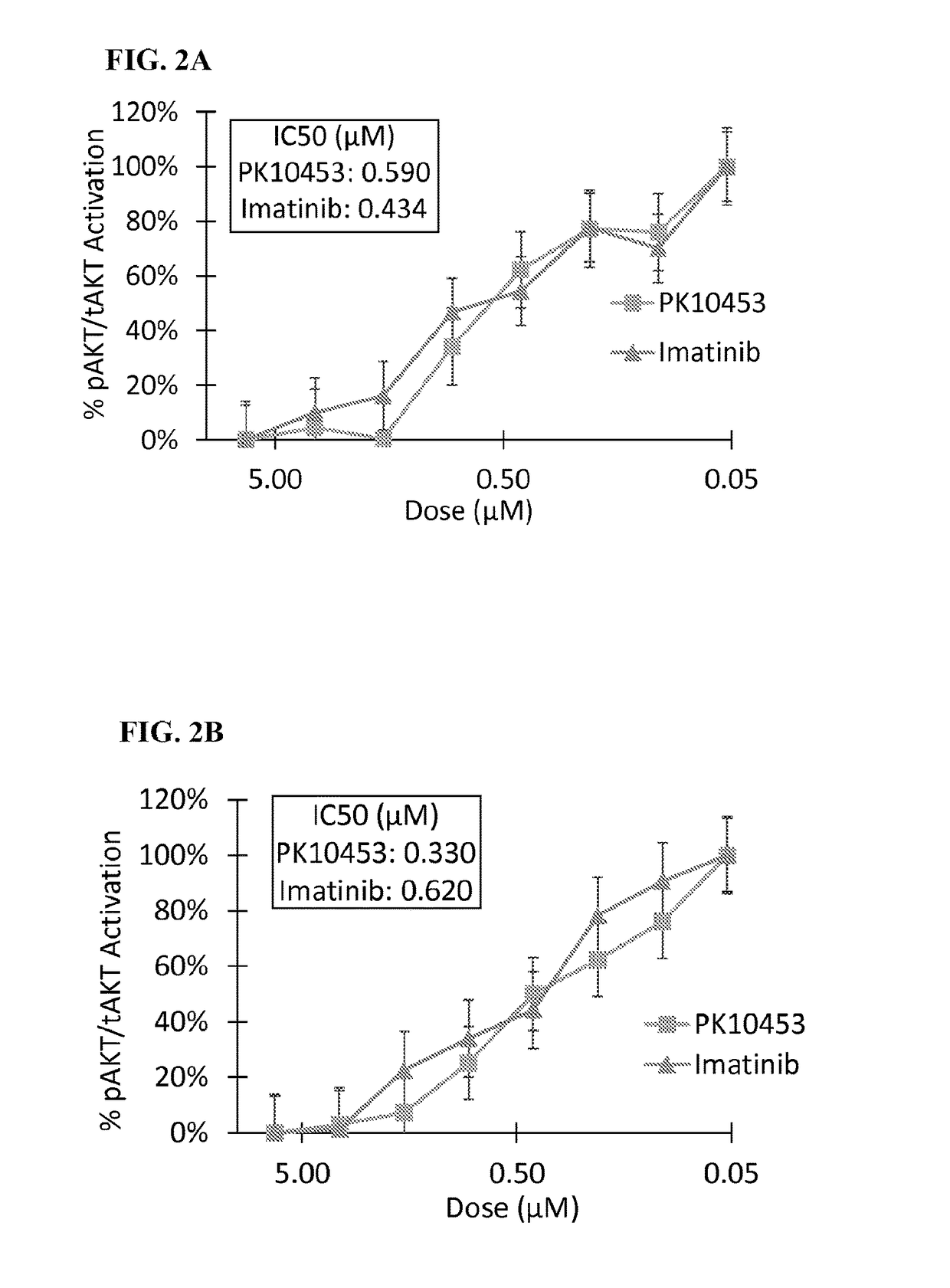Non-selective kinase inhibitors
a kinase inhibitor and non-selective technology, applied in the direction of drug composition, extracellular fluid disorder, metabolic disorder, etc., can solve the problems of mct model criticism, system failure to substantiate certain human disease phenotypes, and confusion of etiological and pathological indications of human disease, so as to improve functional class, improve exercise capacity, and less shortness of breath
- Summary
- Abstract
- Description
- Claims
- Application Information
AI Technical Summary
Benefits of technology
Problems solved by technology
Method used
Image
Examples
example 1
Characterization of PK10453 (Structure 2)
[0194]FIGS. 1A-1D show graphs depicting IC50 concentrations for Imatinab and PK10453 (Structure 2). An in vitro kinase assay demonstrated the IC50 for PK10453 at ATP Km was 35 nM for PDGFR-α, and 10.1 nM for the PDGFR-β. For imatinib the IC50 at ATP Km was 71 nM for PDGFR-α and 607 nM for PDGFR-beta. FIGS. 2A-2E shows graphs of and images of In Cell Western (ICW) assays demonstrating the lower IC50 of PK10453 (Structure 2) against PDGFAA and PDGFBB stimulated phosphorylation of AKT at Ser473 and Thr308 compared to Imatinib in human fetal lung fibroblast. The IC50 of PK10453 for PDGFBB stimulated AKT phosphorylation at Ser473 was 0.13 μM compared to 1.8 μM for imatinib (P50 of PK10453 for PDGFBB stimulated AKT phosphorylation at Thr308 was 0.43 μM vs. 3.25 μM for imatinib (p50 concentrations of PK10453 and imatinib for PDGFAA stimulated phosphorylation of AKT were not significantly different.
[0195]Estimated inhaled dose - PK10453 (Structure 2)...
example 2
MCT Model Efficacy
[0201]FIGS. 5A-5D depict the effect of PK10453 (Structure 2) on right ventricle (RV) systolic pressure (SP) and RV hypertrophy in the MCT and MCT+PN model systems. RVSP values are shown in FIG. 5A. In the vehicle group (n=6), RVSP was 80.4±2.6 mm Hg. For the treatment groups, D2 (n=6), 51.4±6.5; D4 (n=6), 44.4±3.8; and D8 (n=5), 37.1±4.5 mm Hg (p<0.001). Normal control group RVSP was 28.5±2.6 mm Hg (n=3). In the D4 group, there was a 44% reduction in RVSP, and in the D8 group, there was a 54% reduction in RVSP compared to the vehicle treated group. There was also a significant reduction in the degree of RV hypertrophy as measured by the ratio (RV+IVS) / LV weight. See FIG. 5B. The data are represented by this ratio because the septum is shared by the RV and LV. However, use of the RV / (IVS+LV) ratio also showed similar results.
[0202]Moreover, there were 6 animals in the vehicle group but accurate RV end systolic pressures were not obtained due to bleeding in 2 animals...
example 3
Efficacy Studies in the Rat MCT+PN Model
[0203]Telemetry studies. The results of the telemetry study in the rat MCT+PN model are described. At day 0 prior to start of treatment, the PA systolic pressure in the vehicle groups was 41.0±11.7 mm Hg, and in the PK10453 (Structure 2) group, was 43.1±3.5 mm Hg (p=NS). After five days of treatment, the PA systolic pressure was 69.4±12 9 mm Hg in the vehicle group and was significantly lower at 47.3±3.0 mm Hg in the PK10453 group (p<0.01). On treatment day 8, the PA systolic pressure in the vehicle group was 83.5±8.5, but significantly lower at 47.3±4.9 mm Hg in the PK10453 group (p<0.001).
[0204]FIGS. 6A and 6B show graphs for telemetry studies in the rat MCT+PN model. In a separate PK10453 (Structure 2) telemetry study, at day 1 prior to start of treatment, the PA systolic pressure in the vehicle group was 47.4±10.2 mm Hg, and in the PK10453 group, was 43.1±3.5 mm Hg (p=NS). After five days of treatment, the PA systolic pressure was 67.4±11....
PUM
| Property | Measurement | Unit |
|---|---|---|
| particle size | aaaaa | aaaaa |
| particle size | aaaaa | aaaaa |
| particle size | aaaaa | aaaaa |
Abstract
Description
Claims
Application Information
 Login to View More
Login to View More - R&D
- Intellectual Property
- Life Sciences
- Materials
- Tech Scout
- Unparalleled Data Quality
- Higher Quality Content
- 60% Fewer Hallucinations
Browse by: Latest US Patents, China's latest patents, Technical Efficacy Thesaurus, Application Domain, Technology Topic, Popular Technical Reports.
© 2025 PatSnap. All rights reserved.Legal|Privacy policy|Modern Slavery Act Transparency Statement|Sitemap|About US| Contact US: help@patsnap.com



